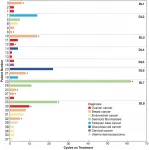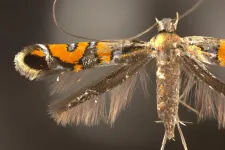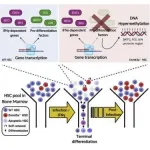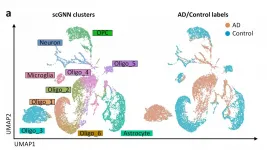(Press-News.org) The burial field in Valsgärde outside Uppsala in central Sweden contains more than 90 graves from the Iron Age.
"On a light note, we could say that Valsgärde is Scandinavia's answer to Sutton Hoo in England as portrayed in the film The Dig on Netflix," says Birgitta Berglund, professor emeritus of archaeology at the Norwegian University of Science and Technology's NTNU University Museum.
Valsgärde is especially known for its spectacular boat graves from the 600s and 700s CE. This timeframe is in the middle of what Norway calls the Merovingian period, the era just before the Viking Age.
Two of these spectacular boat graves are at the centre of this story -- or more specifically, the story is really about the down bedding that was found in the graves.
When researchers from NTNU investigated which birds contributed their feathers to the bedding, they made a surprising discovery that provides new insight into Iron Age society.
The boats carrying the two dead men were about 10 metres long, with room for four to five pairs of oars. Both were outfitted for high-ranking warriors, with richly decorated helmets, shields and weapons. Provisions and tools for hunting and cooking were also included for their last voyage.
In one grave, an Eurasian eagle owl (Bubo bubo) had been laid, with its head cut off. We'll return to that. Horses and other animals were arranged close to the boats.
"The buried warriors appear to have been equipped to row to the underworld, but also to be able to get ashore with the help of the horses," says Berglund.
Beauty sleep was also taken care of in death.Two warriors lay atop several layers of down bedding. The contents of the bedding probably had a greater function than simply serving as filler.
You might have thought of down bedding as a modern concept, which admittedly only became available for common folk in recent times. The down bedding in the graves at Valsgärde is the oldest known from Scandinavia and indicate that the two buried men belonged to the top strata of society.
Wealthy Greeks and Romans used down for their bedding a few hundred years earlier, but down probably wasn't used more widely by wealthy people in Europe until the Middle Ages, Berglund says.
Berglund has been studying down harvesting in Helgeland coastal communities in southern Nordland county for many years, where people commercialized down production early on by building houses for the eider ducks that were the source of the down. The theory was that down from this location might have been exported south, so Berglund wanted to investigate whether the bedding at Valsgärde contained eider down.
"It turned out that a lot of kinds of feathers had been used in the bedding at Valsgärde. Only a few feathers from eider ducks were identified, so we have little reason to believe that they were a commodity from Helgeland or other northern areas," says Berglund.
However, she was not disappointed by this discovery. The great variety of species gave the researchers unique insight into the bird fauna in the immediate area in prehistoric times, along with people's relationship to it.
"The feathers provide a source for gaining new perspectives on the relationship between humans and birds in the past. Archaeological excavations rarely find traces of birds other than those that were used for food," the researcher says.
"We also think the choice of feathers in the bedding may hold a deeper, symbolic meaning. It's exciting."
Berglund explains that according to Nordic folklore, the type of feathers contained in the bedding of the dying person was important.
"For example, people believed that using feathers from domestic chickens, owls and other birds of prey, pigeons, crows and squirrels would prolong the death struggle. In some Scandinavian areas, goose feathers were considered best to enable the soul to be released from the body," she said.
These are well-known folk traditions that have been collected from the 18th century onwards. But they may have their roots in prehistoric times.
In the Icelandic Erik the Red saga, a pillow stuffed with feathers from domestic hens was placed on the throne at Heriólfsnes in Greenland, where a visiting female shaman was to sit. The saga is considered to have been written down in the 13th century, but addresses events around the year 1000, says Berglund.
The examples show that that feathers in the bedding from Valsgärde most likely also had a deeper meaning than just serving as a filler. It's also well known that birds could hold special importance for obtaining information in shamanism -- think of Odin's two ravens Hugin and Munin.
Exactly what ritual function the feathers at Valsgärde had is hard to say. But the bedding contained feathers from geese, ducks, grouse, crows, sparrows, waders and -- perhaps most surprisingly --- eagle owls.
Biologist Jørgen Rosvold, now employed at the Norwegian Institute for Natural History (NINA) identified the species from the feather material.
"It was a time consuming and challenging job for several reasons. The material is decomposed, tangled and dirty. This means that a lot of the special features that you can easily observe in fresh material has become indistinct, and you have to spend a lot more time looking for the distinctive features," Rosvold says.
"I'm still surprised at how well the feathers were preserved, despite the fact that they'd been lying in the ground for over 1000 years."
The feathers in the down bedding weren't the only interesting bird find in the graves. One of the graves also contained a headless owl.
From recent graves we know that people took measures to prevent the buried from returning from the dead, and it's easy to imagine that this was also done longer ago as well.
"We believe the beheading had a ritual significance in connection with the burial," says Berglund.
Swords found in tombs from Viking times were sometimes intentionally bent before being laid in the tomb. This was probably done to prevent the deceased from using the weapon if he returned.
"It's conceivable that the owl's head was cut off to prevent it from coming back. Maybe the owl feather in the bedding also had a similar function? In Salme in Estonia, boat graves from the same period have recently been found that are similar to those in Valsgärde. Two birds of prey with a severed head were found there," says Berglund.
INFORMATION:
Reference: Birgitta Berglund, Jørgen Rosvold. Microscopic identification of feathers from 7th century boat burials at Valsgärde in Central Sweden: Specialized long-distance feather trade or local bird use? Journal of Archaeological Science: Reports, Volume 36, April 2021, 102828.
https://doi.org/10.1016/j.jasrep.2021.102828
Oncotarget published "Phase 1 study of Z-Endoxifen in patients with advanced gynecologic, desmoid, and hormone receptor-positive solid tumors" which reported that Z-endoxifen administration was anticipated to bypass these variations, increasing active drug levels, and potentially benefiting patients responding sub-optimally to tamoxifen.
Patients with treatment-refractory gynecologic malignancies, desmoid tumors, or hormone receptor-positive solid tumors took oral Z-endoxifen daily with a 3 3 phase 1 dose escalation format over 8 dose levels.
Three patients had partial responses and 8 had prolonged stable disease; 44.4% of patients at dose levels 6–8 achieved one of these ...
UPTON, NY — Inspired by the mastery of artificial intelligence (AI) over games like Go and Super Mario, scientists at the National Synchrotron Light Source II (NSLS-II) trained an AI agent – an autonomous computational program that observes and acts – how to conduct research experiments at superhuman levels by using the same approach. The Brookhaven team published their findings in the journal Machine Learning: Science and Technology and implemented the AI agent as part of the research capabilities at NSLS-II.
As a U.S. Department of Energy (DOE) Office of Science User Facility located at DOE’s Brookhaven National Laboratory, NSLS-II enables scientific studies by more than 2000 researchers each year, ...
Akito Kawahara was snapping pictures at a scenic outlook in Hawaii when he spotted the moth equivalent of a dodo.
An entomologist, Kawahara recognized the squiggly patterns on nearby plants as trails carved by leaf-mining caterpillars and lowered his camera to take a closer look. To his astonishment, he saw a tiny moth most experts assumed was extinct. It belonged to a genus known as Philodoria, a type of moth found only in Hawaii and one that hadn’t been documented in the wild since 1976.
“I thought, ‘Oh my God, there’s a Philodoria ...
New research shows that consumers judge 'activist brands' based on how morally competent they are perceived to be when challenging free speech.
The report, co-authored by experts at the Business School (formerly Cass), Birkbeck, University of London and the University of Sussex Business School explains that stakeholders draw their conclusions on the biggest brands by measuring three moral skills: sensitivity, vision, and integration.
Lacking these traits, a brand raising controversy is judged as transgressing, reproducing and manipulating the boundaries of free speech. Displaying these traits proves the brand is not merely 'woke-washing' ...
HOUSTON, TX - March 25, 2021 - Humans are born with tens of thousands of hematopoietic stem cells (HSCs) that collectively ensure lifelong production of blood and immune cells that protect us from infections. HSCs can either duplicate to produce more stem cell progeny or differentiate to produce distinct immune cell lineages, an extremely critical decision that ensures that the body achieves the fine balance between having enough immune cells to fight invaders while still retaining enough HSCs to maintain future blood production. As we age, HSCs accumulate mutations that lead to the ...
More than 150 years ago, the Sun blasted Earth with a massive cloud of hot charged particles. This plasma blob generated a magnetic storm on Earth that caused sparks to leap out of telegraph equipment and even started a few fires. Now called the Carrington Event, after one of the astronomers who observed it, a magnetic storm like this could happen again anytime, only now it would affect more than telegraphs: It could damage or cause outages in wireless phone networks, GPS systems, electrical grids powering life-saving medical equipment and more.
Sun-facing satellites monitor the Sun's ultraviolet (UV) light to give us advance warning of solar storms, both big ones that could cause a Carrington-like ...
NEW YORK, NY--Treatments for a rare retinal disease may be on the horizon after a new study has identified gene variants that cause a metabolic deficiency in the eye.
The disease, macular telangiectasia type 2 (MacTel), has been a research focus of Rando Allikmets, PhD, a pioneer in the genetics of eye diseases, for nearly 15 years. MacTel occurs in approximately 1 in 5,000 adults over age 40 and slowly causes a significant loss of central vision, which can impair driving, reading, and other activities.
"MacTel is clearly a genetic disease because it tends to run in families, but it's been a tough nut to crack," says Allikmets, the William and Donna Acquavella Professor of Ophthalmic Sciences ...
TAMPA, Fla. -- Chimeric antigen receptor T-cell therapy, or CAR T, is a relatively new type of therapy approved to treat several types of aggressive B cell leukemias and lymphomas. Many patients have strong responses to CAR T; however, some have only a short response and develop disease progression quickly. Unfortunately, it is not completely understood why these patients have progression. In an article published in Proceedings of the Royal Society B, Moffitt Cancer Center researchers use mathematical modeling to help explain why CAR T cells work in some patients and not in others.
CAR T is a type of personalized immunotherapy that uses a patient's own T ...
ORLANDO, March 25, 2021 - Early screening can mean the difference between life and death in a cancer and disease diagnosis. That's why University of Central Florida researchers are working to develop a new screening technique that's more than 300 times as effective at detecting a biomarker for diseases like cancer than current methods.
The technique, which was detailed recently in the Journal of the American Chemical Society, uses nanoparticles with nickel-rich cores and platinum-rich shells to increase the sensitivity of an enzyme-linked immunosorbent assay (ELISA).
ELISA is a test ...
Studying genetic material on a cellular level, such as single-cell RNA-sequencing, can provide scientists with a detailed, high-resolution view of biological processes at work. This level of detail helps scientists determine the health of tissues and organs, and better understand the development of diseases such as Alzheimer's that impacts millions of people. However, a lot of data is also generated, and leads to the need for an efficient, easy-to-use way to analyze it.
Now, a team of engineers and scientists from the University of Missouri and the Ohio State University have created a new way to analyze data from single-cell RNA-sequencing ...





